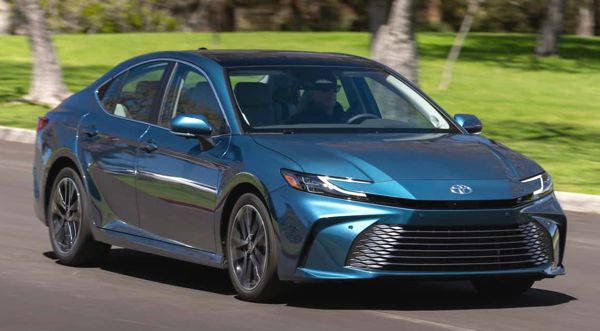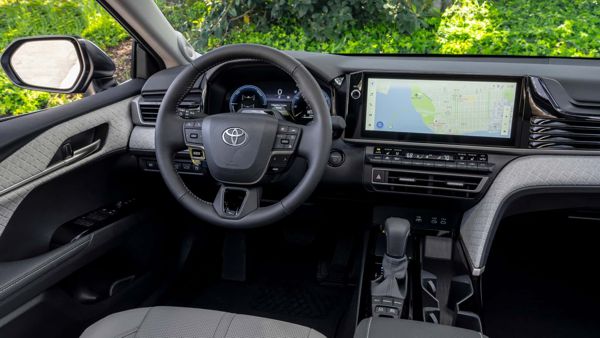Published
on 18
Jul 2017
|
All rights reserved.
|
|
|

|
|
Following
the company strategy, Camry has switched to a radical styling.
|
|
Toyota
Camry has always been high on practicality but short of charm. Its main
selling points are comfort, reliability and value for money, but on the
downside it looks and drives boring. In fact, many Toyotas are just the
same. However, there are signs of change in recent years. Under the
leadership of Akio Toyoda, Toyota group has shifted its design strategy
towards the radical side. New cars like Prius, Mirai, Aygo, C-HR, Lexus
IS, NX, RX, RC and LC are all deemed to be the most radically styled
cars in their respective classes, washing away the conservative image
traditionally associated with the group. This radical theme now extends
to its best-selling family car.
With a total sales number of 389,000 units, the Camry was still the
best-selling car in the USA last year, a title it held for the last 15
years. However, that number represented a 9.5 percent decline, so the
new generation comes at the right time. Like the new Lexus LS, the new
Camry is made much lower, sleeker and sportier. Its nose is slimmer,
its back faster and its roof is lowered by 30mm. The car gets 20mm
wider and 10mm longer. The bonnet is set as much as 40mm lower than
that of the old car, while the waistline is also lowered. Drag
coefficient is lowered slightly from 0.28 to 0.27. The design details
are sharper and more aggressive, especially the big and wide whale
mouth. Again the sport models (SE and XSE) employ different front end
design, extra aero kits and larger, 19-inch wheels shod with wider
tires. Will average American families prefer it? We have to see, but we
definitely do. It might not be as beautiful as Mazda 6, Ford
Fusion/Mondeo or Kia Optima, nor it is as graceful as Volkswagen Passat
or Renault Talisman, but it has an upper hand going against its
arch-rivals Honda Accord (especially the 10th generation just unveiled
last week) and Hyundai Sonata.

|
|
The
bonnet is set as much as 40mm lower than that of the old car, while the
waistline is also lowered.
|
|
The new car is benefited from the TNGA platform of new Prius. It is not
only lighter but most importantly has the rear struts replaced with
double-wishbone suspensions in a bid to improve handling and ride. The
body is strengthened by 30 percent which helps refinement, while center
of gravity is lowered to enhance handling. The wheelbase has been
lengthened by 50mm to 2825mm to match the new class norm. Fears about
the lower roof can be relieved by knowing that the seats are also
mounted lower, by 25mm and 30mm front and rear respectively, so both
headroom loses only 13mm. Disappointingly, despite the longer
wheelbase, rear legroom is reduced by 23mm, mainly due to the
multi-link suspension instead of the more compact struts of the old
car. That said, it is still roomy enough for the class.
Inside, the dashboard design is certainly more interesting than the
bland one on the old car. It is served with updated infotainment system
with larger touchscreen. Although the mass-selling Toyota family car
still uses conventional instrument dials, they sandwich a more
sophisticated 7-inch color trip computer screen (admittedly, base model
comes with a less appealing 4.2-inch unit). Overall the materials and
build quality are quite good without threatening premium brands,
although the large gaps between the dash and door panels look
unimpressive. As expected for a Toyota, ergonomics is good as switches
are logically placed and the center touchscreen is positioned high
enough. Thanks to a lower waistline, the cabin feels airy and affords
good outward visibility. Another good news is that the hybrid
power model finally offers folding rear seats as its more compact
battery has been repositioned under the rear seat. This also gives its
the same trunk space as other models.

|
|
Thanks
to a lower waistline, the cabin feels airy and affords good outward
visibility.
|
|
While Honda, Ford, Chevrolet and Hyundai turned to downsized
turbocharged engines, Toyota Camry sticks with a long-stroke 2.5-liter
four-cylinder for the base model and 3.5-liter V6 for premium models.
However, both of them gain D-4S direct and port injection system to
enable higher compression ratio hence more power. Called “Dynamic
Force”, the 2.5-liter four-cylinder is an all-new design, with a longer
stroke, cooled exhaust gas recirculation, on-demand water and oil pumps
to achieve 26 percent lower fuel consumption. Its thermal efficiency is
a Prius-matching 40 percent, thanks in part to the ability to run on
Atkinson cycle at lighter loads. When it reverts to Otto-cycle, peak
output reaches 203 hp (or 206 hp with sport exhaust) and 184 lbft of
torque, up 25 hp and 14 lbft from the old engine.
The 3.5-liter V6 is also capable to run in either Atkinson or Otto
cycle. It produces 301 hp and 267 lbft, up 33 hp and 19 lbft. Save the
more expensive Ford Fusion V6 Sport, this is the most powerful car in
its class. Both engines mate with a new 8-speed automatic transmission,
replacing the outgoing 6-speeder for better fuel economy.
The Camry Hybrid uses an Atkinson-cycle version of the 2.5 engine,
whose higher power makes up the smaller electric motor for a combined
output of 208 hp. A planetary CVT is again responsible for combining
the two power sources. Sadly, there is no plug-in hybrid version for
the Camry, although the TNGA platform does allow that.
 |
|
Obviously,
priority has been shifted from pleasing women or elderly to those
demanding more involvement.
|
|
On the road, the new Camry retains the comfy ride and low noise level
traditionally associated with the nameplate, but it gains a lot in
driver appeal. The new rear suspension, lower center of gravity and
stiffer chassis combined to result in tighter body control, no matter
in corners or over undulations. It also resists understeer strongly.
The electric power steering is still no model for feel, but now it
weighs up noticeably in corner to give you more confidence. The brake
pedal is also more adequately weighted, no longer featherweight. Hybrid
model no longer suffers from a non-linear brake pedal feel. Obviously,
priority has been shifted from pleasing women or elderly to those
demanding more involvement. While it is still no match for, say, Mazda
6 or Ford Fusion for sporty handling, the new found balance between
handling and ride is refreshing to Toyota’s customers. More important,
such a change of character can be found across the range, not just on
the Sport models as their suspension settings are largely the same –
only the wheels, tires and bushings etc. are different.
The V6 is smooth yet powerful, but predictably its extra weight results
in less agility and mushier steering feel, while a hint of torque steer
is inevitable under heavy throttle. The long-stroke 2.5 engine does the
job perfectly in everyday driving situations, but when being stretched
it could sound coarse. Compared with its rivals’ turbo motors it needs
to be revved harder to deliver the same performance. Meanwhile, the
Hybrid's CVT still suffers from rubberband effect, which hampers
refinement under acceleration. However, it is no deny that Toyota’s
naturally aspirated engines usually deliver better fuel economy than
rivals’ turbocharged motors in the real world. They are also likely to
be more reliable and cheaper to repair.
Thanks to the new direction by Akio Toyoda, this is the first time in
my memory that Toyota Camry achieves a 4-star rating. With a sportier
look and driving experience, it deserves so. However, is it outstanding
enough to better the Volkswagen Passat, Ford Fusion/Mondeo, Mazda 6 or
Skoda Octavia? I don’t think so. It is more competitive than ever for
sure, but to be a class-leader, it takes more.
|
Verdict:     |
Published
on 10
May 2024
|
All rights reserved.
|
|
Camry facelift (2024)
|
|

|
|
Camry
gets leaner than ever in a shrinking market.
|
|
Over the last 10 years, US
sales of Toyota Camry dropped gradually from 429,000 to 291,000 units
in a declining market environment that lost Ford Fusion, Buick Regal,
Chrysler 200 and Volkswagen Passat. More worrying, the casualty list
will be joined with Chevrolet Impala, Nissan Altima and Subaru Legacy
shortly. Undoubtedly, SUV crossovers steal a lot of sales from mid-size
sedans, which used to be the best selling passenger car segment in
North America. Anticipating sales to keep declining, Toyota delayed the
full makeover of Camry. The current generation has been around since
2017, about time to be replaced, yet Toyota introduces just a mild
update to extend its lifecycle, hopefully for another few years.
Externally, the biggest change to the car is the nose, which gets new
grilles and headlights that look very different from the outgoing
model. The comfort-oriented LE and XLE models differentiate more from
the sportier SE and XSE models in front grille design – the former uses
horizontal grille elements with chrome, while the latter employs matt
black mesh grille. At the back, changes are pretty much limited to the
taillights, yet they are not massively different.
However, the biggest change is the interior, where the dashboard is
thoroughly redesigned. Analogue instrument is replaced by a digital
display, while center touchscreen is enlarged and moved up, air vents
moved down. Trims and materials feel higher quality, too. The new
infotainment system with large touchscreen is definitely more inviting
to use. The new seats are more comfortable. Space remain competitive,
accommodating six-footers in both rows, although the sloping roof line
still makes entry to the rear seats a little difficult.

|
|
Extra
sound insulation solidifies the Camry’s role as a comfortable family
car.
|
|
Lower sales volume means the Camry cannot keep all powertrain options
alive. Gone is the entry-level 4-cylinder powertrain. The range-topping
301hp V6 is also shown the door, sadly, leaving the 4-cylinder hybrid
as the sole powertrain offering. While we moan the demise of the V6, we
can understand, because very few customers actually buy Camry for
performance and driving excitement. Even Honda Accord, more renowned
for driver appeal, ditched its 2-liter turbo engine in the last update.
Meanwhile, the hybrid is the best selling powertrain in Camry, and its
frugal/green nature is future-proofed.
To make the hybrid less boring, Toyota improves it with a more powerful
propulsion motor, gaining 16 horsepower, while the Dynamic Force
2.5-liter four-pot engine gains 8 horsepower, so the combined output is
lifted from 208 to 225 hp. Expect 0-60 mph to improve by a half second
to mid-7 seconds range. The more powerful electric motor also enables
the Camry to run on battery power more the time, improving refinement
and fuel economy – EPA combined figure is expected to be up to 50 mpg!
Under hard acceleration, the planetary CVT gearbox still drones the
engine heavily, but most other time remains quiet and smooth.
The chassis gains extra sound insulation so that the cabin gets
quieter, solidifying the Camry’s role as a comfortable family car. The
suspension tuning is slightly stiffer on all models, which helps
tightening body motions a little without threatening Honda Accord or
Mazda 6 as the driver’s choice in the class. Even the sportier-tuned SE
and XSE models are not exactly fun to drive, blame partly to numb
steering, partly to lack of poke. Having killed V6 power, is it
ridiculous to sell these sports models anymore. Perhaps they will be
casualties of the next round update.
|
Verdict:    |
|